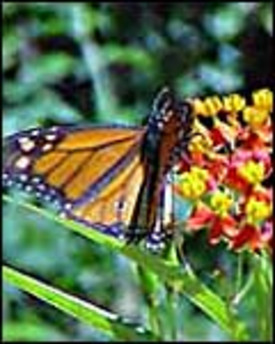By planting specific plants that are attractive to various butterfly species, you can create a sea of fluttering color in your garden each summer.
Planning a Butterfly Garden
|
You only need a small garden bed to create an inviting oasis for butterflies. Both butterflies and plants like sun so plan your garden with a southern exposure or in a site that gets at least six hours of sun each day. A site sheltered from the wind by trees, shrubs, or a building will prevent tall plants from blowing over, and allow your butterflies to feed, mate, and lay eggs in relative tranquility.
Nectar Flowers
Nectar flowers provide a source of food for adult butterflies. Butterflies are attracted to brightly colored, sweet-smelling flowers that allow them easy access. Composite daisy-like flowers are favorites. Some of the preferred, easy-to-grow nectar plants are: aster, black-eyed Susan, butterfly bush, butterfly weed, cosmos, goldenrod, lantana, lavender, liatris, marigold, purple coneflower, and zinnia. Butterflies are attracted to masses of color and fragrance, so try to plant groups of flowers instead of single plants. If space is limited, however, even window boxes can catch butterflies’ attention.
Host Plants
Host plants are those preferred by butterfly larvae (caterpillars). They are usually wildflowers, shrubs, and trees native to the area. Some species will lay eggs on only one type of host plant (for example, monarch caterpillars that eat only milkweed), while others are less particular. Some of the primary plants for butterfly larvae include: aspen, alfalfa, clover, nettle, pearly everlasting, milkweed, grasses, hackberry, parsley, vetch, and willow. Although the caterpillars of some butterflies, like the cabbage white, are considered vegetable garden pests, you should never use pesticides–even biological ones–in a butterfly garden or you’ll destroy your intended guests.
Water and Warmth
Puddles or other shallow water sources are important, primarily for male butterflies, more as a source of salt and amino acids than as a water source. If you have no naturally occurring puddles, try sinking a shallow container filled with moist sand, dirt, and/or stones into the ground. Keep it moist and watch for large congregations of butterflies. Dark stones in your garden can provide a warm spot where adult butterflies can bask in the sun and warm their bodies for flying.
Credit: National Gardening Association





























